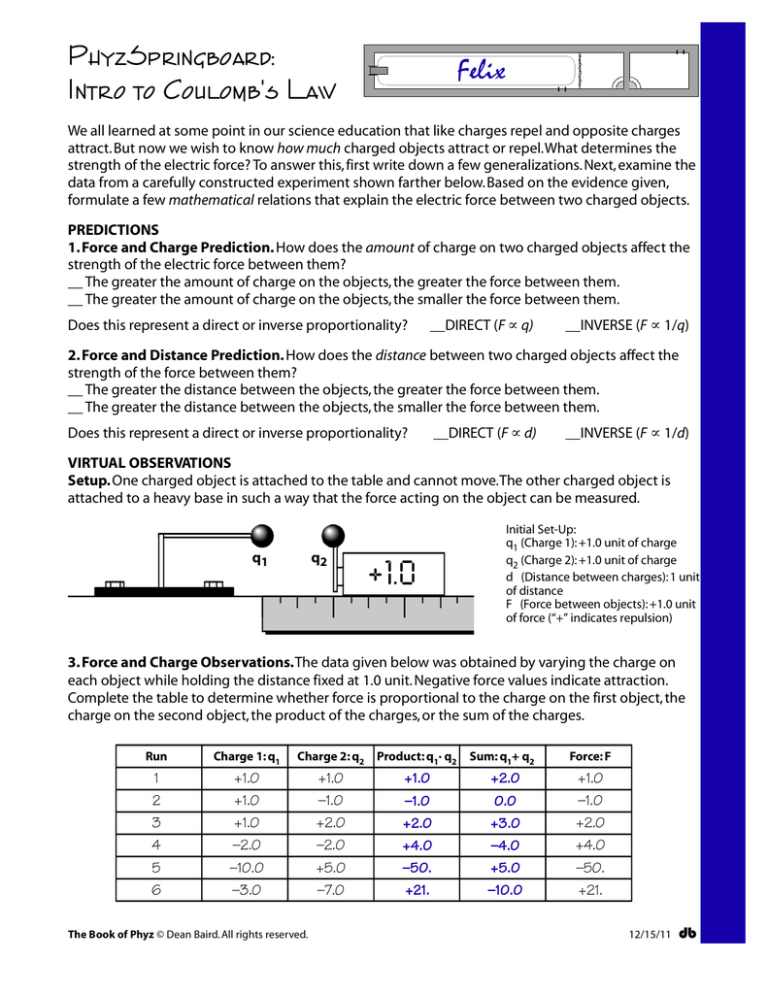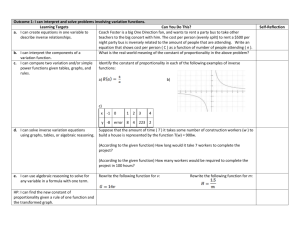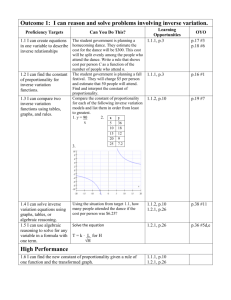
PhyzSpringboard:
Intro to Coulomb's Law
Felix
We all learned at some point in our science education that like charges repel and opposite charges
attract.But now we wish to know how much charged objects attract or repel.What determines the
strength of the electric force? To answer this, first write down a few generalizations. Next, examine the
data from a carefully constructed experiment shown farther below.Based on the evidence given,
formulate a few mathematical relations that explain the electric force between two charged objects.
PREDICTIONS
1. Force and Charge Prediction. How does the amount of charge on two charged objects affect the
strength of the electric force between them?
__ The greater the amount of charge on the objects, the greater the force between them.
__ The greater the amount of charge on the objects, the smaller the force between them.
Does this represent a direct or inverse proportionality?
__DIRECT (F ∝ q)
__INVERSE (F ∝ 1/q)
2. Force and Distance Prediction. How does the distance between two charged objects affect the
strength of the force between them?
__ The greater the distance between the objects, the greater the force between them.
__ The greater the distance between the objects, the smaller the force between them.
Does this represent a direct or inverse proportionality?
__DIRECT (F ∝ d)
__INVERSE (F ∝ 1/d)
VIRTUAL OBSERVATIONS
Setup.One charged object is attached to the table and cannot move.The other charged object is
attached to a heavy base in such a way that the force acting on the object can be measured.
q1
q2
+1.0
Initial Set-Up:
q1 (Charge 1): +1.0 unit of charge
q2 (Charge 2): +1.0 unit of charge
d (Distance between charges): 1 unit
of distance
F (Force between objects): +1.0 unit
of force (“+” indicates repulsion)
3. Force and Charge Observations.The data given below was obtained by varying the charge on
each object while holding the distance fixed at 1.0 unit. Negative force values indicate attraction.
Complete the table to determine whether force is proportional to the charge on the first object, the
charge on the second object, the product of the charges, or the sum of the charges.
Run
Charge 1: q1
1
2
3
4
5
6
+1.0
+1.0
+1.0
–2.0
–10.0
–3.0
Charge 2: q2 Product: q1· q2
The Book of Phyz © Dean Baird. All rights reserved.
+1.0
–1.0
+2.0
–2.0
+5.0
–7.0
+1.0
–1.0
+2.0
+4.0
–50.
+21.
Sum: q1+ q2
Force: F
+2.0
0.0
+3.0
–4.0
+5.0
–10.0
+1.0
–1.0
+2.0
+4.0
–50.
+21.
12/15/11
db
Based on this information, what is the mathematical relationship between the charge on two objects
and the force between them? (Which column of values looks most like those in the force column?)
__F ∝ q1
__F ∝ q2
__F ∝ q1 · q2
__F ∝ q1 + q2
4. Force and Distance Observations.The data given below was obtained by varying the distance
between the two objects while holding the charge on each object fixed at +1.0 unit.Complete the
table to determine whether the force is inversely proportional to the distance, square root of the
distance, or square of the distance.
Run
Distance d
Inverse : 1/d
1
2
3
4
5
6
0.250
0.500
1.00
2.00
4.00
7.00
+4.00
+2.00
+1.00
+0.500
+0.250
+0.143
Inverse Sqr.: 1/d2
Force: F
+2.00
+1.41
+1.00
+0.707
+16.0
+4.00
+1.00
+0.250
+0.500
+0.378
+0.0625
+0.0204
+16.0
+4.00
+1.00
+0.250
+0.0625
+0.0204
Inverse Root: 1/ d
Based on this information, what is the mathematical relationship between the separation distance of
two charged objects and the force between them?
__F ∝ 1/d
__F ∝ 1/d2
__F ∝ 1/ d
5.The Complete Proportionality.Synthesize the results in parts 1 and 2: what is the relationship
between electrostatic force, charge, and separation distance?
F ∝ q1q2/d2
6.Turning the Proportionality into an Equation.To transform the proportionality above to a fullfledged equation, we must add a constant of proportionality to the expression. In other words, we will
change the proportionality F ∝ X (where X is the expression derived in question 5) to the equation
F = kX.
a.Write the full equation.
F = kq1q2/d2
b.Use the numerical data below to determine the magnitude and units of measure of the constant k.
When q1 = 0.004 C, q2 = 0.006 C,and d = 50 m, F = 85 N.
k = Fd2/q1q2
k = 85 N · (50 m)2 / (0.004 C)(0.006 C)
9 x 109 N·m2/C2
k = ____________________________
The Book of Phyz © Dean Baird. All rights reserved.
12/15/11
db





